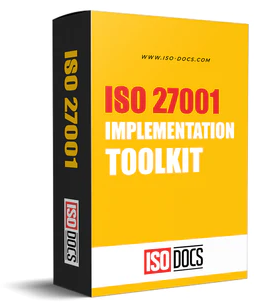How To Get ISO 27001 Certification?
In our data-driven landscape, safeguarding sensitive information is paramount. ISO 27001 certification offers a proven pathway to ensuring robust information security practices within organizations. This globally recognized standard outlines a comprehensive framework for establishing an Information Security Management System (ISMS).

Achieving ISO 27001 certification validates an organization's commitment to data protection and enhances its credibility and competitive edge. Explore the critical steps necessary to attain ISO 27001 certification, guiding organizations toward a secure and trusted future in an increasingly interconnected world.
Understanding ISO 27001 Certification
ISO 27001 certification signifies an organization's dedication to maintaining the highest information security standards. This globally recognized framework outlines establishing, implementing, and continuously improving an Information Security Management System (ISMS). By comprehensively addressing risks and vulnerabilities, ISO 27001 ensures the confidentiality, integrity, and availability of sensitive data.
Achieving ISO 27001 certification showcases an organization's commitment to proactive data protection, compliance with regulations, and bolstering stakeholder confidence. It is a structured approach to fortify digital resilience in an interconnected world, safeguarding against threats and positioning organizations as custodians of secure information ecosystems.
Benefits of ISO 27001 Certification
ISO 27001 certification offers a multitude of compelling benefits for organizations. Firstly, it enhances data security by systematically identifying and mitigating risks, reducing the likelihood of breaches and cyberattacks. This leads to increased stakeholder confidence and trust, reinforcing the organization's reputation. Compliance with legal and regulatory requirements is streamlined, avoiding costly penalties.
The certification also provides a competitive advantage, signaling clients and partners a commitment to safeguarding their sensitive information. Internally, it fosters improved processes and resource allocation, driving operational efficiency. Vendor relationships are strengthened due to the heightened security standards, while clear incident management guidelines prepare the organization to respond effectively to potential breaches. In a data-centric landscape, ISO 27001 certification is a strategic investment that reaps dividends regarding security, compliance, trust, and organizational excellence.
Key Steps to Obtain ISO 27001 Certification
Step 1: Management Support and Commitment:
Management support and commitment are pivotal to ISO 27001 certification. Leadership endorsement creates a foundation for an effective Information Security Management System (ISMS). Allocate necessary resources, communicate the value of certification, address resistance, and lead by example. Establish a steering committee to oversee implementation and ensure sustained engagement. Management's proactive involvement fosters a culture of security awareness and drives successful ISO 27001 certification.
Step 2: Establishing an Information Security Management System (ISMS):
Establishing an ISMS is central to ISO 27001 certification. Define ISMS scope, roles, and responsibilities. Conduct an inventory of information assets. Develop policies, procedures, and risk assessment methodologies. This foundation sets the stage for comprehensive information security and successful ISO 27001 certification.
Step 3: Conducting a Risk Assessment:
Conducting a risk assessment is pivotal for ISO 27001 certification. Identify potential threats, vulnerabilities, and impacts on information assets. Prioritize risks based on likelihood and impact. This assessment forms the basis for implementing targeted security controls and ensuring a robust information security framework.
Step 4: Implementing Controls and Measures:
Implementing controls and measures is essential for ISO 27001 certification. Based on the risk assessment, deploy security controls to mitigate identified risks. These measures encompass access controls, encryption, incident response, and more. Effective implementation enhances data protection and positions the organization for ISO 27001 certification success.
Step 5: Documentation and Training:
Documentation and training are crucial for ISO 27001 certification. Create detailed documentation of ISMS policies, procedures, and processes. Conduct thorough training sessions to educate employees about their roles in information security. Well-documented practices and informed personnel strengthen the organization's readiness for ISO 27001 certification.
Step 6: Internal Audit:
Internal audit is vital for ISO 27001 certification. Independently assess ISMS implementation and control effectiveness. Identify gaps, non-conformities, and areas for improvement. Regular internal audits ensure continuous enhancement, bolstering the organization's readiness for an external certification assessment and validating its commitment to robust information security practices.
Step 7: Management Review:
Management review is pivotal for ISO 27001 certification. Regularly assess ISMS performance, effectiveness, and alignment with organizational objectives. Analyze audit results, incident reports, and improvement initiatives. This strategic evaluation ensures the ISMS remains robust, adaptable, and aligned with ISO 27001 standards, enhancing the organization's preparedness for certification and long-term information security excellence.
Choosing a Certification Body
Selecting the right certification body is pivotal in the ISO 27001 journey. A reputable certification body should possess international accreditation, industry expertise, and a proven track record in information security assessments. Consider geographical coverage and compatibility with your organization's values and goals.
Thoroughly evaluating certification bodies ensures that the ISO 27001 assessment process is unbiased, rigorous, and aligned with the highest standards. Making an informed choice in this regard is integral to achieving ISO 27001 certification and establishing lasting confidence in your organization's commitment to information security.
Maintaining ISO 27001 Certification
Maintaining ISO 27001 certification is an ongoing commitment to information security excellence. Regularly review and update your ISMS to adapt to emerging threats and organizational changes. Conduct periodic internal audits to ensure continued compliance with ISO 27001 standards. Stay engaged with your chosen certification body through routine assessments to validate sustained adherence.
By continuously refining and enhancing your information security practices, you reaffirm your dedication to safeguarding sensitive data. ISO 27001 certification becomes a dynamic tool, showcasing your resilience and proactive approach to mitigating risks and maintaining the highest level of data protection and stakeholder trust.
Conclusion
Obtaining ISO 27001 certification is a strategic investment that fortifies an organization's information security posture. This journey entails meticulous planning, risk assessment, control implementation, and rigorous audits. Achieving ISO 27001 certification demonstrates a commitment to safeguarding sensitive data and cultivates a culture of vigilance and continuous improvement.
By adhering to international standards and best practices, organizations enhance their resilience against cyber threats and foster stakeholder confidence and trust. As technology evolves, ISO 27001 certification remains a steadfast beacon guiding organizations toward robust information security and positioning them as leaders in a world where data integrity is paramount.


